Kettle path in astrophoto. Part 1 - Equipment
Without exaggeration, we can say that astrophotography is one of the most technically complex sections of photography. The difficulties lie not only in some remoteness of the objects of observation, but also in various moments of an organizational nature.
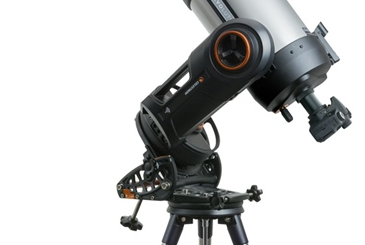
Astronomy as a hobby interest me for a long time, and finally there was a practical opportunity to try myself in this matter. The number of rakes along this path can be counted by a dozen, and perhaps a similar article will save beginners from unnecessary spending.
"How it works," details under the cut.
Speaking very simplistically, telescopes come in 3 varieties, depending on the type of mount used. After all, as was said long ago by Galileo, still the Earth rotates, and the telescope must turn after the stars in the sky. Therefore, the mount is no less important part of the telescope than the optical tube itself.
So, there are 3 types of mounts:
- Equatorial mount
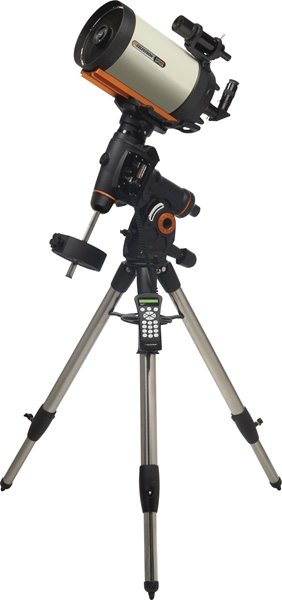
The most correct type of mount in relation to astrophoto. The mounting axis is directed towards the North Star (the axis of rotation of the earth), so ideally the telescope rotates “synchronously” with the sky. "Ideally," because in reality, the mechanics are imperfect, and pointing at a polar star too, in general, the N1 rake is buried here, which is solved firstly by buying a good mount (about $ 1000) and optionally an additional guiding camera that more accurately holds the star in the center (200- 300 $). You may also need all kinds of fasteners and other pieces of iron, which do not come with the telescope, but they are pretty decent.
Rake N2 - as you can see from the photo, the mount is quite bulky and heavy, in addition to the telescope there are also balances, the total weight of the structure can be 20-30 kg.
- Alt-azimuth mount
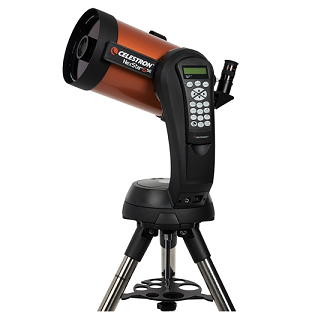
This type of mount is easier and simpler, requires less space and is generally quite good. However, as you might guess, the observer loses in quality, in particular due to the fact that the telescope axis rotates asynchronously with the earth axis, the so-called "field rotation" takes place, which is why long exposures are impossible. This is a rake N3.
However, for short exposures this is not so critical, and if you wish, you can buy the so-called "equatorial wedge". With it azimuthal mount is essentially transformed into equatorial and telescope will beraskoryaku something like this:
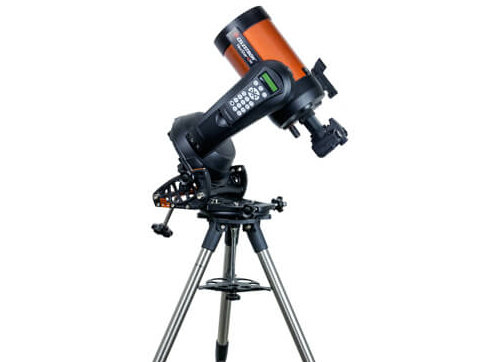
The price of this wedge of about $ 300, that is, rake N4, so IMHO it's not worth it - if you put the aim to make high-quality photos, it's easier to buy an equatorial mount immediately, than to do such a dubious upgrade.
In my case, everything was decided for me - the equatorial mount doesn’t fit on my balcony, so there wasn’t any choice, I had to take the alt-azimuth one.
- Dobson
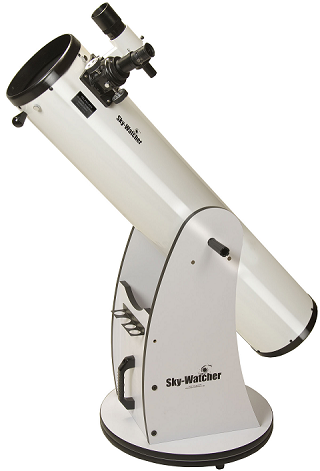
Mount The easiest and cheapest type of mount. For an astrophoto, by and large, it is not suitable at all, except for the Moon and planets. Now there are Dobson's computerized mounts with electric motors, but their price is quite considerable, and there is no sense in this for astrophoto in general.
However, the plus of Dobson mounts is its cheapness - for example, for the same price you can buy a 125mm telescope with electronics, or a 200mm telescope with a Dobson mount. Obviously, the second will show much more. In general, if there is not enough money, you can also think about it.
By and large, the aperture is not so critical for astrophotography - unlike the eye, the camera can accumulate light. But you also want to look through the telescope, so this parameter is very important. It all depends solely on the price and financial ability of the buyer. Approximately, several options can be distinguished:
- up to 120mm: in fact, there is a larger toy in which you can see something, but the choice of objects will be very limited. Issue price up to $ 600.
- 120-160mm: the average level, quite suitable for both the beginning and for further "growth". The issue price is $ 600-1,200.
- 200mm and above: for highly advanced amateurs, there are already questions about both price and dimensions.
In general, there is a N5 rake here - this is the mass and dimensions of the telescope. You can buy just a great telescope weighing 30 kg, and the desire to take it out to the street will disappear for the third time of observation. A telescope with a diameter of 5-8 "is quite a good compromise to begin with, allowing you to see a lot of things on the one hand, and on the other hand, it’s not so stressful in terms of dimensions and price.
Of course, there are other parameters, such as optical design, aperture, focal length, but cannot be described as a whole in one article.
In my case, based on the compactness requirement, the Celestron Nexstar 6 telescope was purchased. "
Once upon a time, 5-10 years ago, astronomy lovers put digital dust boxes on telescopes through adapters and remade webcams. Now it has become irrelevant, there are more or less ready-made solutions, there are two main manufacturers of amateur cameras: QHY and ZWO. The camera is connected to the telescope instead of the eyepiece; USB2 or USB3 is used as the interface.
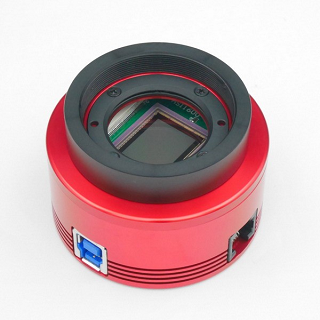
As in any other photo equipment, the price here depends on the size of the matrix and the number of megapixels. Still cameras are monochrome and color, models with and without cooling. The approximate price of the issue is from $ 200 to $ 2000, more or less an average price for an amateur can be considered $ 400-500: for this money you can buy a camera with a resolution of 2-6MPx and shutter speeds of up to 1000s. In principle, more is not necessary, even a telescope of the middle price range will not provide such parameters.
If you have a DSLR camera with interchangeable lenses, you can use it by purchasing an appropriate adapter.
As mentioned above, astronomical cameras are mainly connected via USB. The camera sends an uncompressed video stream to the computer (compression is inappropriate here, because we want to consider the details of objects and not mpeg artifacts). So a laptop with USB3.0 and enough disk space is desirable (1 minute of uncompressed video takes about a gigabyte).
For all amateur astronomy, this is the most difficult moment. By and large, faint stars in cities have not been seen for a long time, as they wrote here on geektimes, a generation of people has grown who have not seen the Milky Way (I myself saw it for the first time in 25 years). In general, this is the N6 rake - in the city, the telescope will show 10% of its capabilities by force. Ideally, in order to see the dark sky, in the case of Moscow or St. Petersburg, you need to drive 80 kilometers. You can find out more precisely by looking at the site your location on the sitewww.lightpollutionmap.info . Of course, nobody will dangle every clear night at 80km, so it remains to come to terms with what is, and choose from the available options. Happy owners of a private home can watch in the backyard, this is the best option, for the rest there is either a summer house or a balcony (extreme type of equipment removal with a total price of $ 2500 per street yard I do not consider).
In the case of observations on the balcony there is a rake N7 - this is the heat flux from the building. In the cold season, warm air rises from the windows, and the image is noticeably “soaped”. This is not visible with the eye, but with a magnification of 100-200x, the atmosphere already critically affects the quality.
At high magnification, the star can be seen something like this:
What can be seen is very different from the image of a star in Stellarium. Fortunately, for photography this is not so critical, because software allows you to select the best shots from a long series.
In total, the following objects are available for astronomical observations / photographs:
- The Moon and the Sun (always with a filter)
- Planets
- Nebulae and galaxies
If we talk about observations from the city, then the observer can actually see the first 2 points (only the brightest ones are visible from nebulae). Based on this, in my case, the choice was made in favor of the "planetary" telescope, with a large increase but a small aperture.
On this, a brief overview of the “iron” necessary for astrophotography can be completed. As you can see, not everything is simple, and there are many nuances here, both for the wallet, and for the questions “what to choose”, and for organizational issues.
The software for photographing and processing the results will be discussed in the next part.
PS: I immediately want to answer the question that is likely to follow - "why is this necessary." In general, the answer is simple - just because it's interesting. Of course, the majority of amateur observations and photographs have no scientific, global or highly artistic value. Even with a 14 "telescope it’s not possible to get a photo better than the professional observatory in Chile does. However, as a hobby, it’s no worse than diving, skiing or collecting stamps. Moreover, studying image processing technologies is also very interesting, and may be useful in other areas.
“Nothing captivates me more than the starry sky above my head and the moral law in me,” wrote Immanuel Kant. Astronomy and astrophotography is one of the ways to get to know the sky better, although one cannot but admit that with the modern development of civilization it is more and more difficult to see the sky ...

Astronomy as a hobby interest me for a long time, and finally there was a practical opportunity to try myself in this matter. The number of rakes along this path can be counted by a dozen, and perhaps a similar article will save beginners from unnecessary spending.
"How it works," details under the cut.
Telescope selection
Mount
Speaking very simplistically, telescopes come in 3 varieties, depending on the type of mount used. After all, as was said long ago by Galileo, still the Earth rotates, and the telescope must turn after the stars in the sky. Therefore, the mount is no less important part of the telescope than the optical tube itself.
So, there are 3 types of mounts:
- Equatorial mount

The most correct type of mount in relation to astrophoto. The mounting axis is directed towards the North Star (the axis of rotation of the earth), so ideally the telescope rotates “synchronously” with the sky. "Ideally," because in reality, the mechanics are imperfect, and pointing at a polar star too, in general, the N1 rake is buried here, which is solved firstly by buying a good mount (about $ 1000) and optionally an additional guiding camera that more accurately holds the star in the center (200- 300 $). You may also need all kinds of fasteners and other pieces of iron, which do not come with the telescope, but they are pretty decent.
Rake N2 - as you can see from the photo, the mount is quite bulky and heavy, in addition to the telescope there are also balances, the total weight of the structure can be 20-30 kg.
- Alt-azimuth mount

This type of mount is easier and simpler, requires less space and is generally quite good. However, as you might guess, the observer loses in quality, in particular due to the fact that the telescope axis rotates asynchronously with the earth axis, the so-called "field rotation" takes place, which is why long exposures are impossible. This is a rake N3.
However, for short exposures this is not so critical, and if you wish, you can buy the so-called "equatorial wedge". With it azimuthal mount is essentially transformed into equatorial and telescope will be

The price of this wedge of about $ 300, that is, rake N4, so IMHO it's not worth it - if you put the aim to make high-quality photos, it's easier to buy an equatorial mount immediately, than to do such a dubious upgrade.
In my case, everything was decided for me - the equatorial mount doesn’t fit on my balcony, so there wasn’t any choice, I had to take the alt-azimuth one.
- Dobson

Mount The easiest and cheapest type of mount. For an astrophoto, by and large, it is not suitable at all, except for the Moon and planets. Now there are Dobson's computerized mounts with electric motors, but their price is quite considerable, and there is no sense in this for astrophoto in general.
However, the plus of Dobson mounts is its cheapness - for example, for the same price you can buy a 125mm telescope with electronics, or a 200mm telescope with a Dobson mount. Obviously, the second will show much more. In general, if there is not enough money, you can also think about it.
Aperture (lens diameter)
By and large, the aperture is not so critical for astrophotography - unlike the eye, the camera can accumulate light. But you also want to look through the telescope, so this parameter is very important. It all depends solely on the price and financial ability of the buyer. Approximately, several options can be distinguished:
- up to 120mm: in fact, there is a larger toy in which you can see something, but the choice of objects will be very limited. Issue price up to $ 600.
- 120-160mm: the average level, quite suitable for both the beginning and for further "growth". The issue price is $ 600-1,200.
- 200mm and above: for highly advanced amateurs, there are already questions about both price and dimensions.
In general, there is a N5 rake here - this is the mass and dimensions of the telescope. You can buy just a great telescope weighing 30 kg, and the desire to take it out to the street will disappear for the third time of observation. A telescope with a diameter of 5-8 "is quite a good compromise to begin with, allowing you to see a lot of things on the one hand, and on the other hand, it’s not so stressful in terms of dimensions and price.
Of course, there are other parameters, such as optical design, aperture, focal length, but cannot be described as a whole in one article.
In my case, based on the compactness requirement, the Celestron Nexstar 6 telescope was purchased. "
Camera selection
Once upon a time, 5-10 years ago, astronomy lovers put digital dust boxes on telescopes through adapters and remade webcams. Now it has become irrelevant, there are more or less ready-made solutions, there are two main manufacturers of amateur cameras: QHY and ZWO. The camera is connected to the telescope instead of the eyepiece; USB2 or USB3 is used as the interface.

As in any other photo equipment, the price here depends on the size of the matrix and the number of megapixels. Still cameras are monochrome and color, models with and without cooling. The approximate price of the issue is from $ 200 to $ 2000, more or less an average price for an amateur can be considered $ 400-500: for this money you can buy a camera with a resolution of 2-6MPx and shutter speeds of up to 1000s. In principle, more is not necessary, even a telescope of the middle price range will not provide such parameters.
If you have a DSLR camera with interchangeable lenses, you can use it by purchasing an appropriate adapter.
Laptop selection
As mentioned above, astronomical cameras are mainly connected via USB. The camera sends an uncompressed video stream to the computer (compression is inappropriate here, because we want to consider the details of objects and not mpeg artifacts). So a laptop with USB3.0 and enough disk space is desirable (1 minute of uncompressed video takes about a gigabyte).
Selection of the observation site
For all amateur astronomy, this is the most difficult moment. By and large, faint stars in cities have not been seen for a long time, as they wrote here on geektimes, a generation of people has grown who have not seen the Milky Way (I myself saw it for the first time in 25 years). In general, this is the N6 rake - in the city, the telescope will show 10% of its capabilities by force. Ideally, in order to see the dark sky, in the case of Moscow or St. Petersburg, you need to drive 80 kilometers. You can find out more precisely by looking at the site your location on the sitewww.lightpollutionmap.info . Of course, nobody will dangle every clear night at 80km, so it remains to come to terms with what is, and choose from the available options. Happy owners of a private home can watch in the backyard, this is the best option, for the rest there is either a summer house or a balcony (extreme type of equipment removal with a total price of $ 2500 per street yard I do not consider).
In the case of observations on the balcony there is a rake N7 - this is the heat flux from the building. In the cold season, warm air rises from the windows, and the image is noticeably “soaped”. This is not visible with the eye, but with a magnification of 100-200x, the atmosphere already critically affects the quality.
At high magnification, the star can be seen something like this:
Youtube video
What can be seen is very different from the image of a star in Stellarium. Fortunately, for photography this is not so critical, because software allows you to select the best shots from a long series.
What to watch?
In total, the following objects are available for astronomical observations / photographs:
- The Moon and the Sun (always with a filter)
- Planets
- Nebulae and galaxies
If we talk about observations from the city, then the observer can actually see the first 2 points (only the brightest ones are visible from nebulae). Based on this, in my case, the choice was made in favor of the "planetary" telescope, with a large increase but a small aperture.
Conclusion
On this, a brief overview of the “iron” necessary for astrophotography can be completed. As you can see, not everything is simple, and there are many nuances here, both for the wallet, and for the questions “what to choose”, and for organizational issues.
The software for photographing and processing the results will be discussed in the next part.
PS: I immediately want to answer the question that is likely to follow - "why is this necessary." In general, the answer is simple - just because it's interesting. Of course, the majority of amateur observations and photographs have no scientific, global or highly artistic value. Even with a 14 "telescope it’s not possible to get a photo better than the professional observatory in Chile does. However, as a hobby, it’s no worse than diving, skiing or collecting stamps. Moreover, studying image processing technologies is also very interesting, and may be useful in other areas.
“Nothing captivates me more than the starry sky above my head and the moral law in me,” wrote Immanuel Kant. Astronomy and astrophotography is one of the ways to get to know the sky better, although one cannot but admit that with the modern development of civilization it is more and more difficult to see the sky ...
